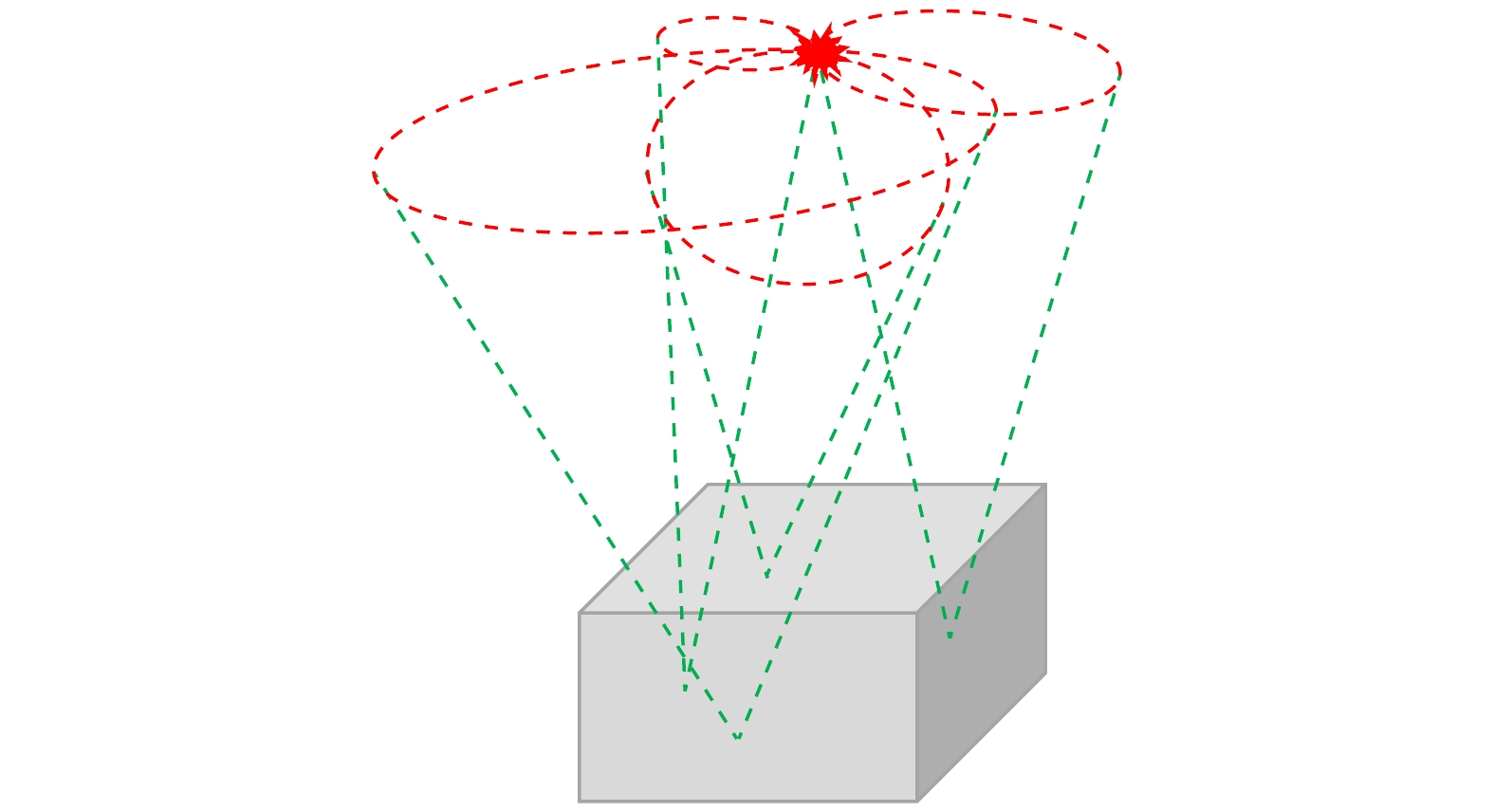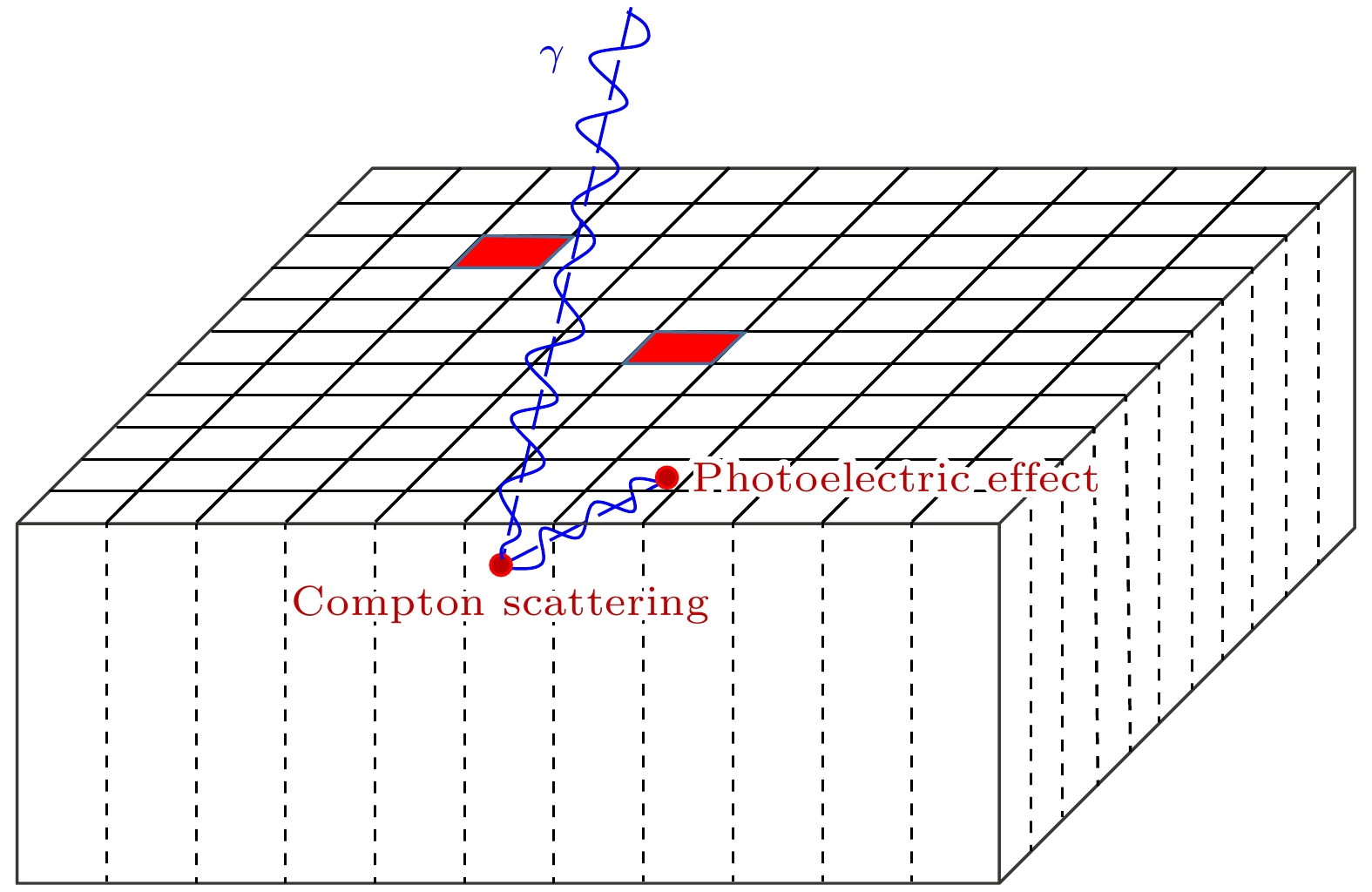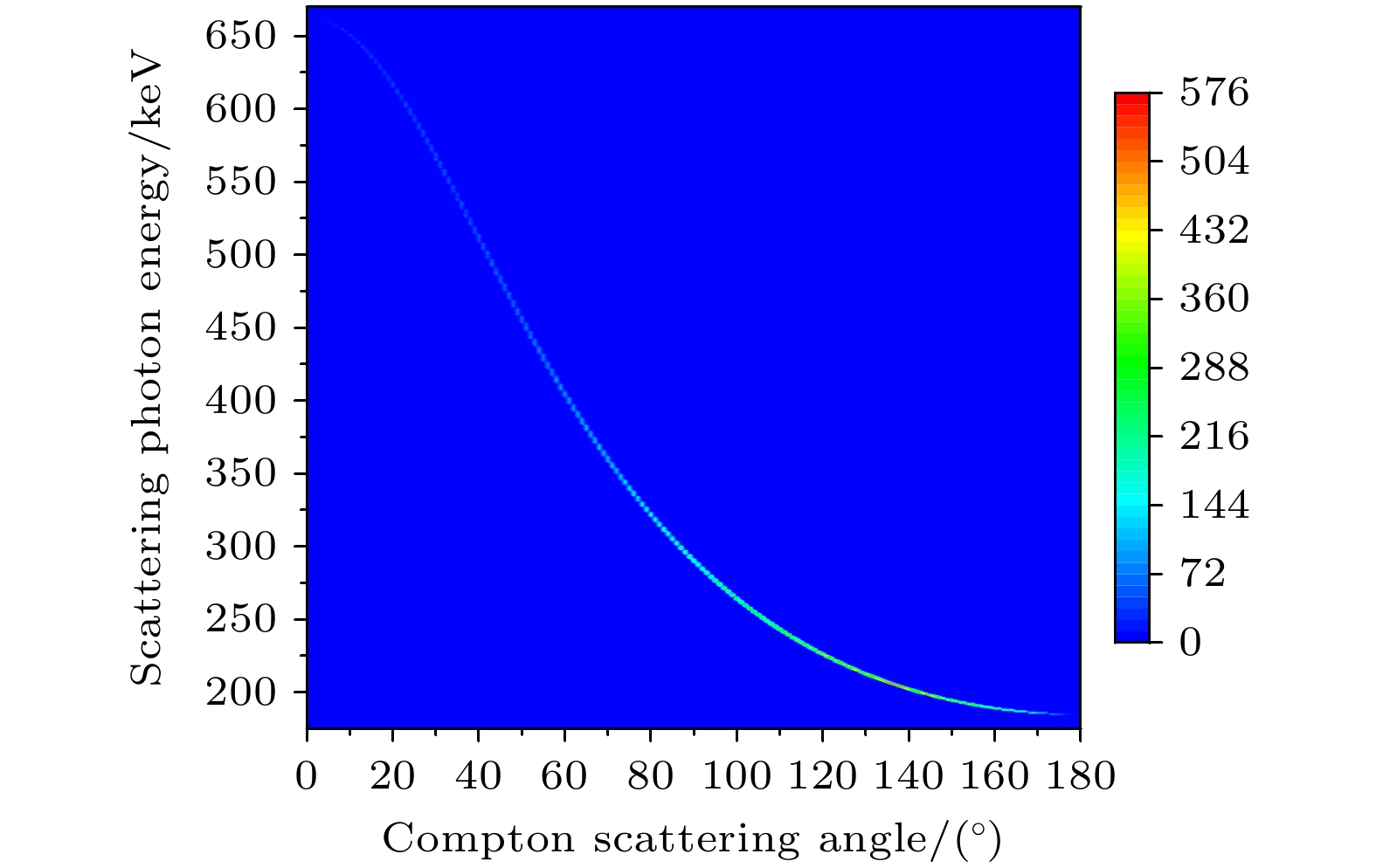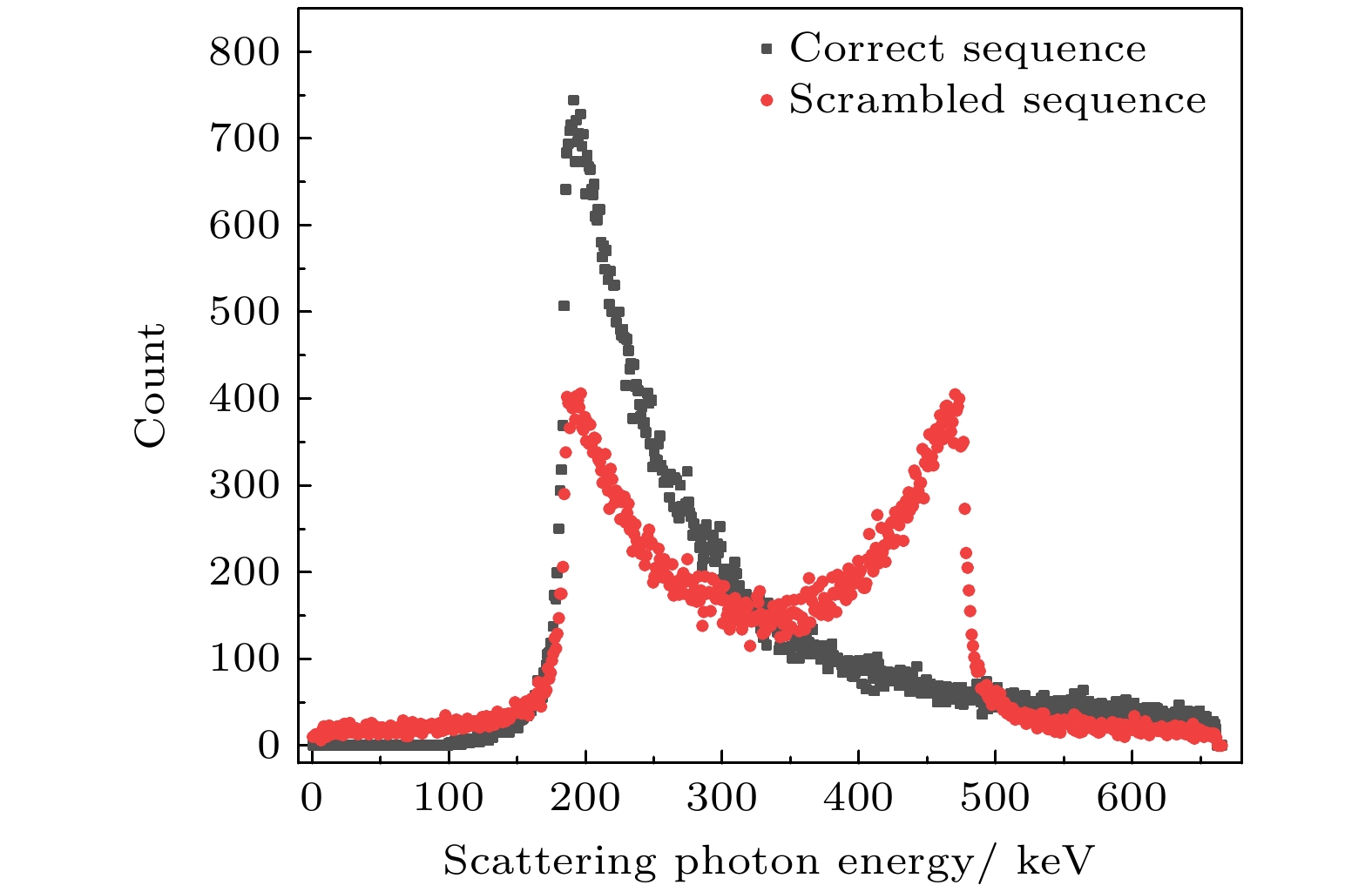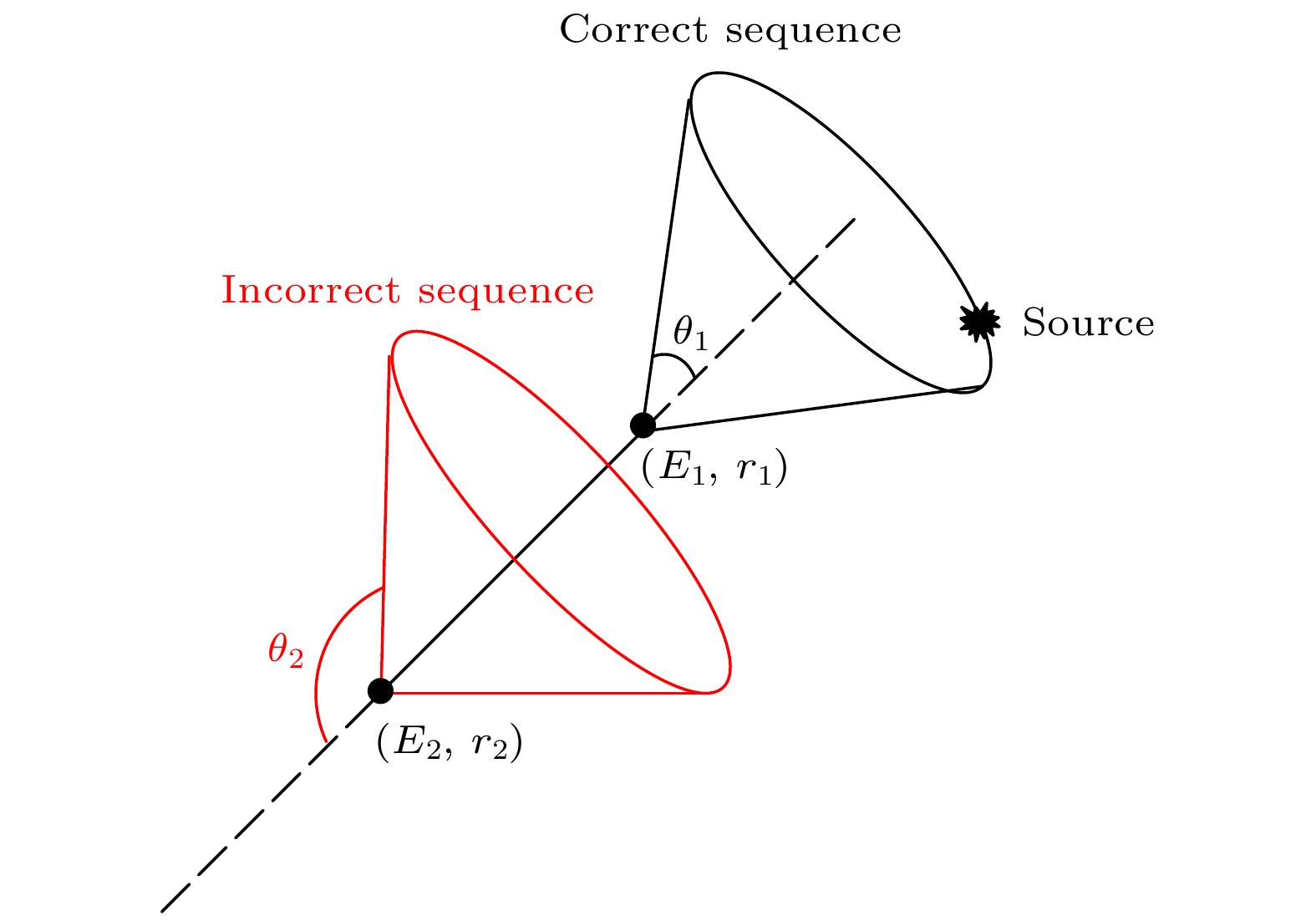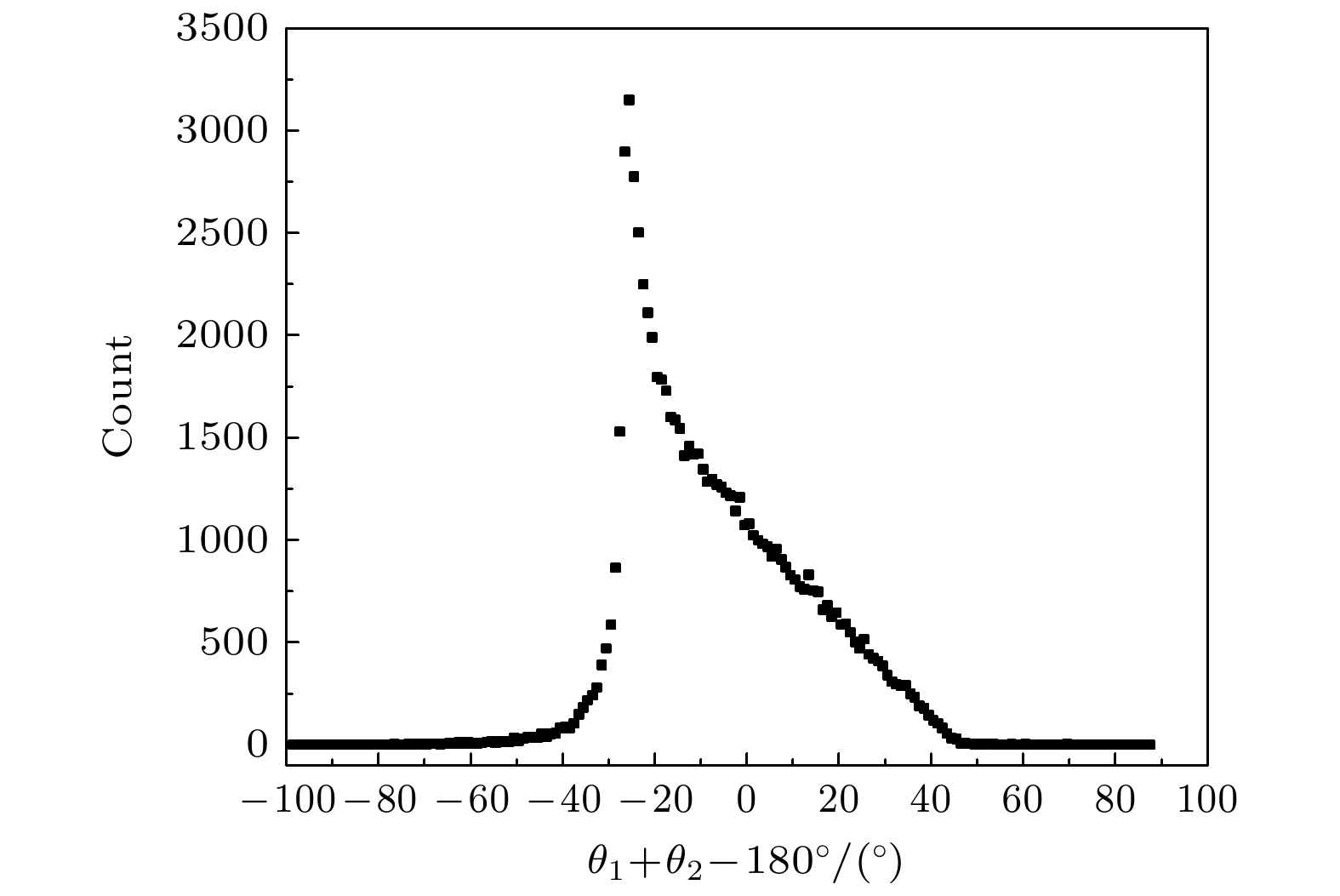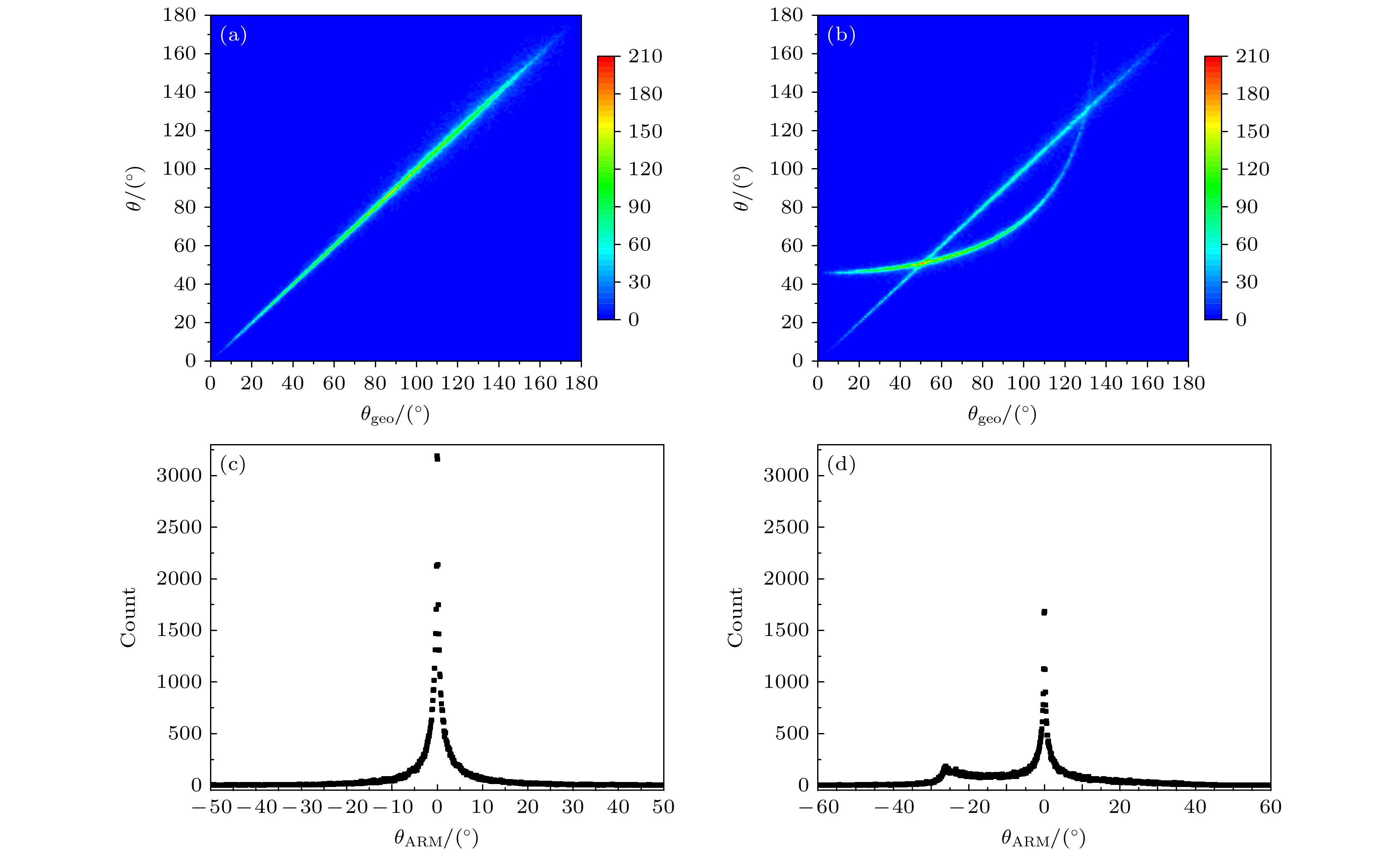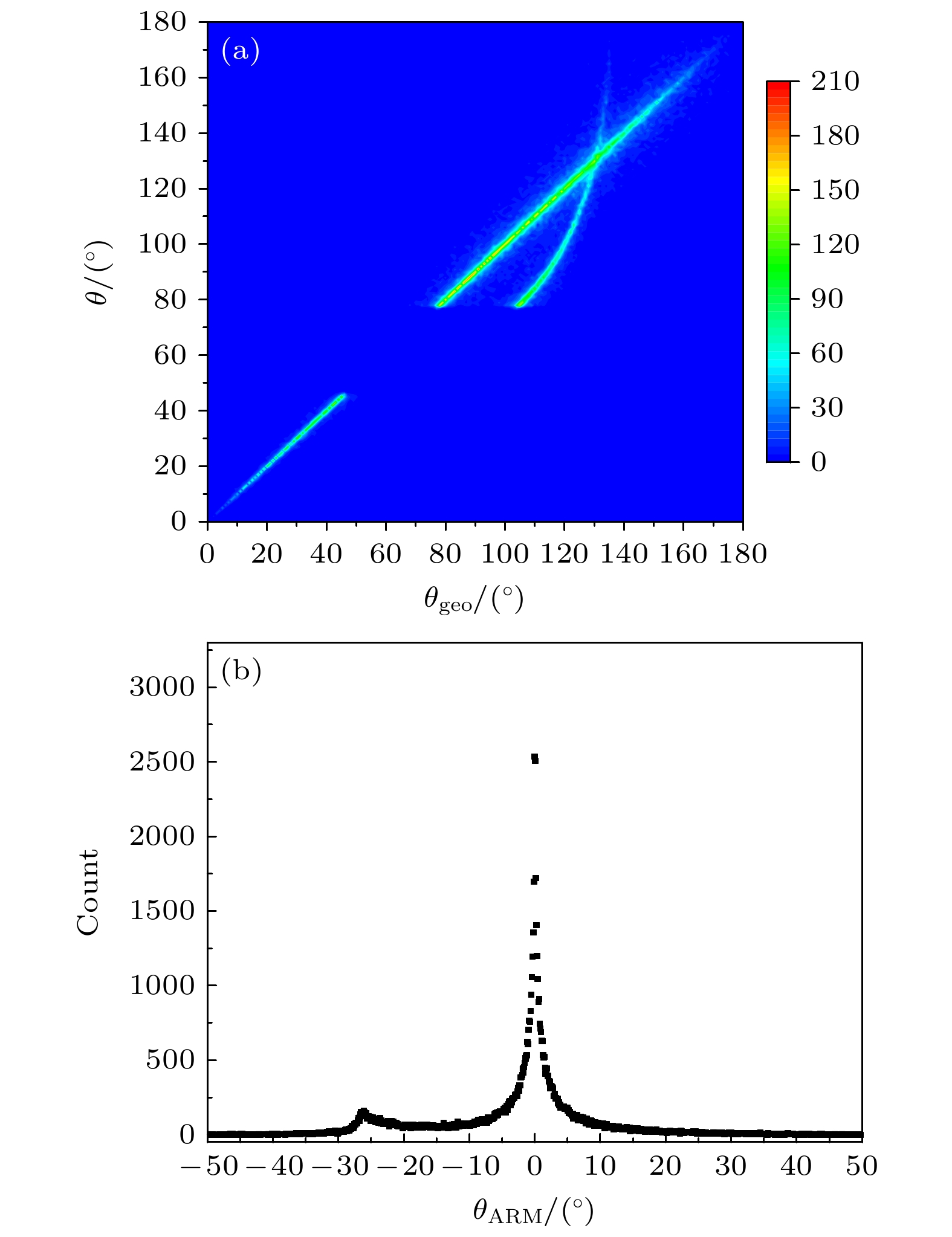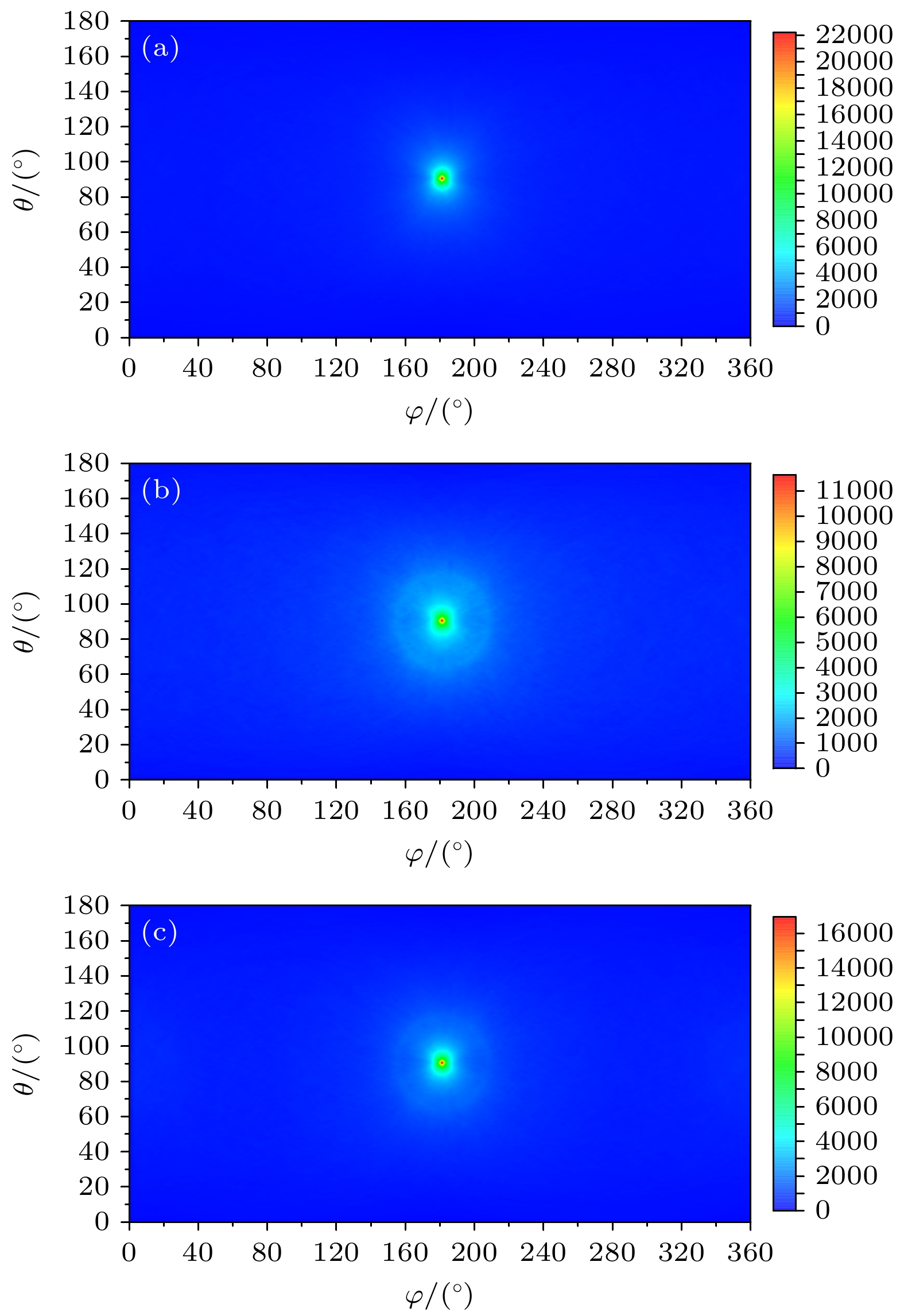-
The Compton camera for γ-ray imaging has the advantages of light weight, high detection efficiency, and wide imaging energy range. However, it is difficult for the detection system to distinguish between the Compton scattering event and scattering photon absorption event, which results in erroneous image reconstruction. In this work, a simulation model of Compton camera based on a three-dimensional position-sensitive CdZnTe detector is constructed using GEANT4 program. The detection of characteristic γ-ray from a far-field 137Cs point-like source is simulated. The location of the interaction and energy deposition in the detector are recorded by means of event-by-event. The Compton scattering angles of effective Compton scattering events and imaging of the radioactive source are reconstructed using a simple back-projection algorithm which is an image reconstruction algorithm suitable for real-time imaging scenes. The influences of event sequence reconstruction on the imaging resolution and its improvement are investigated. The results show that the influence of incorrect sequence events on imaging resolution is mainly in the area within 30° deviation from the source position, resulting in a decrease in the density of the image points distributed at the source position. Incorrectly reconstructed image points are generated near the source position and form a ring at 26°. The percentage of correctly sequenced events increases to 82% by using Compton edge test and simple comparison method based on the deposited energy for sequencing events. The density of image points distributed at the source location is improved by 47%, and the incorrect reconstruction of the image point distribution near the source location is greatly suppressed, resulting in an improved imaging resolution. The research results provide support for designing Compton camera and optimizing image reconstruction.
-
Keywords:
- Compton camera /
- GEANT4 /
- sequence reconstruction /
- imaging resolution
[1] Todd R W, Nightingale J M, Everett D B 1974 Nature 251 132
 Google Scholar
Google Scholar
[2] Gal O, Gmar M, Ivanov O P, Lainé F, Lamadie F, Le Goaller C, Mahé C, Manach E, Stepanov V E 2006 Nucl. Instrum. Methods Phys. Res. A 563 233
 Google Scholar
Google Scholar
[3] 孙世峰 2020 69 198701
 Google Scholar
Google Scholar
Sun S F 2020 Acta Phys. Sin. 69 198701
 Google Scholar
Google Scholar
[4] 杨靖, 谭放, 吴玉迟, 谷渝秋 2016 核电子学与探测技术 36 966
 Google Scholar
Google Scholar
Yang J, Tan F, Wu Y C, Gu Y Q 2016 Nucl. Electron. Detect. Technol. 36 966
 Google Scholar
Google Scholar
[5] Strong A 1996 Space Sci. Rev. 76 205
 Google Scholar
Google Scholar
[6] Kamae T, Hanada N, Enomoto R 1988 IEEE Trans. Nucl. Sci. 35 352
 Google Scholar
Google Scholar
[7] Mihailescu L, Vetter K, Burks M, Hull E, Craig W 2007 Nucl. Instrum. Methods Phys. Res. A 570 89
 Google Scholar
Google Scholar
[8] He Z, Li W, Knoll G, Wehe D, Berry J, Stahle C 1999 Nucl. Instrum. Methods Phys. Res. A 422 173
 Google Scholar
Google Scholar
[9] Du Y, He Z, Knoll G, Wehe D, Li W 2001 Nucl. Instrum. Methods Phys. Res. A 457 203
 Google Scholar
Google Scholar
[10] Lehner C E, He Z, Zhang F 2004 IEEE Trans. Nucl. Sci. 51 1618
 Google Scholar
Google Scholar
[11] Wahl C G, Kaye W, Wang W, Zhang F, Jaworski J, Boucher Y A, King A, He Z 2014 IEEE Nuclear Science Symposium and Medical Imaging Conference (NSS/MIC) Seattle, USA, November 8–15, 2014 p1
[12] 宋张勇, 于得洋, 蔡晓红 2019 68 118701
 Google Scholar
Google Scholar
Song Z Y, Yu D Y, Cai X H 2019 Acta Phys. Sin. 68 118701
 Google Scholar
Google Scholar
[13] 王薇, 李传龙, 吴建华, 李兴隆 2019 原子能科学技术 53 2471
 Google Scholar
Google Scholar
Wang W, Li C L, Wu J H, Li X L 2019 Atomic Energy Sci. Tech. 53 2471
 Google Scholar
Google Scholar
[14] Song Z Y, Zhang B Z, Yu D Y 2021 Nucl. Phys. Rev. 38 215
 Google Scholar
Google Scholar
[15] Shy D, He Z 2020 Nucl. Instrum. Methods Phys. Res. A 954 161443
 Google Scholar
Google Scholar
[16] Xiaofeng G, Qingpei X, Dongfeng T, Yi W, Fanhua H, Yingzeng Z, Chengsheng C, Na L 2017 Appl. Radiat. Isot. 124 93
 Google Scholar
Google Scholar
[17] Liu Y L, Fu J Q, Li Y L, Li Y J, Ma X M, Zhang L 2018 Nucl. Sci. Tech. 29 1
 Google Scholar
Google Scholar
[18] 张峰, 闫镔, 汪先超, 江桦, 魏星 2013 62 168702
 Google Scholar
Google Scholar
Zhang F, Yan B, Wang X C, Jiang H, Wei X 2013 Acta Phys. Sin. 62 168702
 Google Scholar
Google Scholar
[19] Agostinelli S, Allison J, Amako K 2003 Nucl. Instrum. Methods Phys. Res. A 506 250
 Google Scholar
Google Scholar
[20] Tian F, Geng C R, Yao Z Y, Wu R Y, Xu J F, Cai F, Tang X B 2022 Phys. Med. 96 140
 Google Scholar
Google Scholar
[21] Xu D, He Z, Lehner C E, Zhang F 2004 Hard X-Ray and Gamma-Ray Detector Physics VI Denver, USA, October 21, 2004 p144
-
图 8 $\theta $和${\theta _{{\text{geo}}}}$差异分布 (a) 正确排序事件; (b)混乱排序事件. ${\theta _{{\text{ARM}}}}$分布 (c) 正确排序事件; (d) 混乱排序事件
Figure 8. Distribution of the difference between $\theta $ and ${\theta _{{\text{geo}}}}$: (a) Correct sequence events; (b) scrambled sequence events. Distribution of ${\theta _{{\text{ARM}}}}$: (c) Correct sequence events; (d) scrambled sequence events.
-
[1] Todd R W, Nightingale J M, Everett D B 1974 Nature 251 132
 Google Scholar
Google Scholar
[2] Gal O, Gmar M, Ivanov O P, Lainé F, Lamadie F, Le Goaller C, Mahé C, Manach E, Stepanov V E 2006 Nucl. Instrum. Methods Phys. Res. A 563 233
 Google Scholar
Google Scholar
[3] 孙世峰 2020 69 198701
 Google Scholar
Google Scholar
Sun S F 2020 Acta Phys. Sin. 69 198701
 Google Scholar
Google Scholar
[4] 杨靖, 谭放, 吴玉迟, 谷渝秋 2016 核电子学与探测技术 36 966
 Google Scholar
Google Scholar
Yang J, Tan F, Wu Y C, Gu Y Q 2016 Nucl. Electron. Detect. Technol. 36 966
 Google Scholar
Google Scholar
[5] Strong A 1996 Space Sci. Rev. 76 205
 Google Scholar
Google Scholar
[6] Kamae T, Hanada N, Enomoto R 1988 IEEE Trans. Nucl. Sci. 35 352
 Google Scholar
Google Scholar
[7] Mihailescu L, Vetter K, Burks M, Hull E, Craig W 2007 Nucl. Instrum. Methods Phys. Res. A 570 89
 Google Scholar
Google Scholar
[8] He Z, Li W, Knoll G, Wehe D, Berry J, Stahle C 1999 Nucl. Instrum. Methods Phys. Res. A 422 173
 Google Scholar
Google Scholar
[9] Du Y, He Z, Knoll G, Wehe D, Li W 2001 Nucl. Instrum. Methods Phys. Res. A 457 203
 Google Scholar
Google Scholar
[10] Lehner C E, He Z, Zhang F 2004 IEEE Trans. Nucl. Sci. 51 1618
 Google Scholar
Google Scholar
[11] Wahl C G, Kaye W, Wang W, Zhang F, Jaworski J, Boucher Y A, King A, He Z 2014 IEEE Nuclear Science Symposium and Medical Imaging Conference (NSS/MIC) Seattle, USA, November 8–15, 2014 p1
[12] 宋张勇, 于得洋, 蔡晓红 2019 68 118701
 Google Scholar
Google Scholar
Song Z Y, Yu D Y, Cai X H 2019 Acta Phys. Sin. 68 118701
 Google Scholar
Google Scholar
[13] 王薇, 李传龙, 吴建华, 李兴隆 2019 原子能科学技术 53 2471
 Google Scholar
Google Scholar
Wang W, Li C L, Wu J H, Li X L 2019 Atomic Energy Sci. Tech. 53 2471
 Google Scholar
Google Scholar
[14] Song Z Y, Zhang B Z, Yu D Y 2021 Nucl. Phys. Rev. 38 215
 Google Scholar
Google Scholar
[15] Shy D, He Z 2020 Nucl. Instrum. Methods Phys. Res. A 954 161443
 Google Scholar
Google Scholar
[16] Xiaofeng G, Qingpei X, Dongfeng T, Yi W, Fanhua H, Yingzeng Z, Chengsheng C, Na L 2017 Appl. Radiat. Isot. 124 93
 Google Scholar
Google Scholar
[17] Liu Y L, Fu J Q, Li Y L, Li Y J, Ma X M, Zhang L 2018 Nucl. Sci. Tech. 29 1
 Google Scholar
Google Scholar
[18] 张峰, 闫镔, 汪先超, 江桦, 魏星 2013 62 168702
 Google Scholar
Google Scholar
Zhang F, Yan B, Wang X C, Jiang H, Wei X 2013 Acta Phys. Sin. 62 168702
 Google Scholar
Google Scholar
[19] Agostinelli S, Allison J, Amako K 2003 Nucl. Instrum. Methods Phys. Res. A 506 250
 Google Scholar
Google Scholar
[20] Tian F, Geng C R, Yao Z Y, Wu R Y, Xu J F, Cai F, Tang X B 2022 Phys. Med. 96 140
 Google Scholar
Google Scholar
[21] Xu D, He Z, Lehner C E, Zhang F 2004 Hard X-Ray and Gamma-Ray Detector Physics VI Denver, USA, October 21, 2004 p144
Catalog
Metrics
- Abstract views: 706
- PDF Downloads: 21
- Cited By: 0














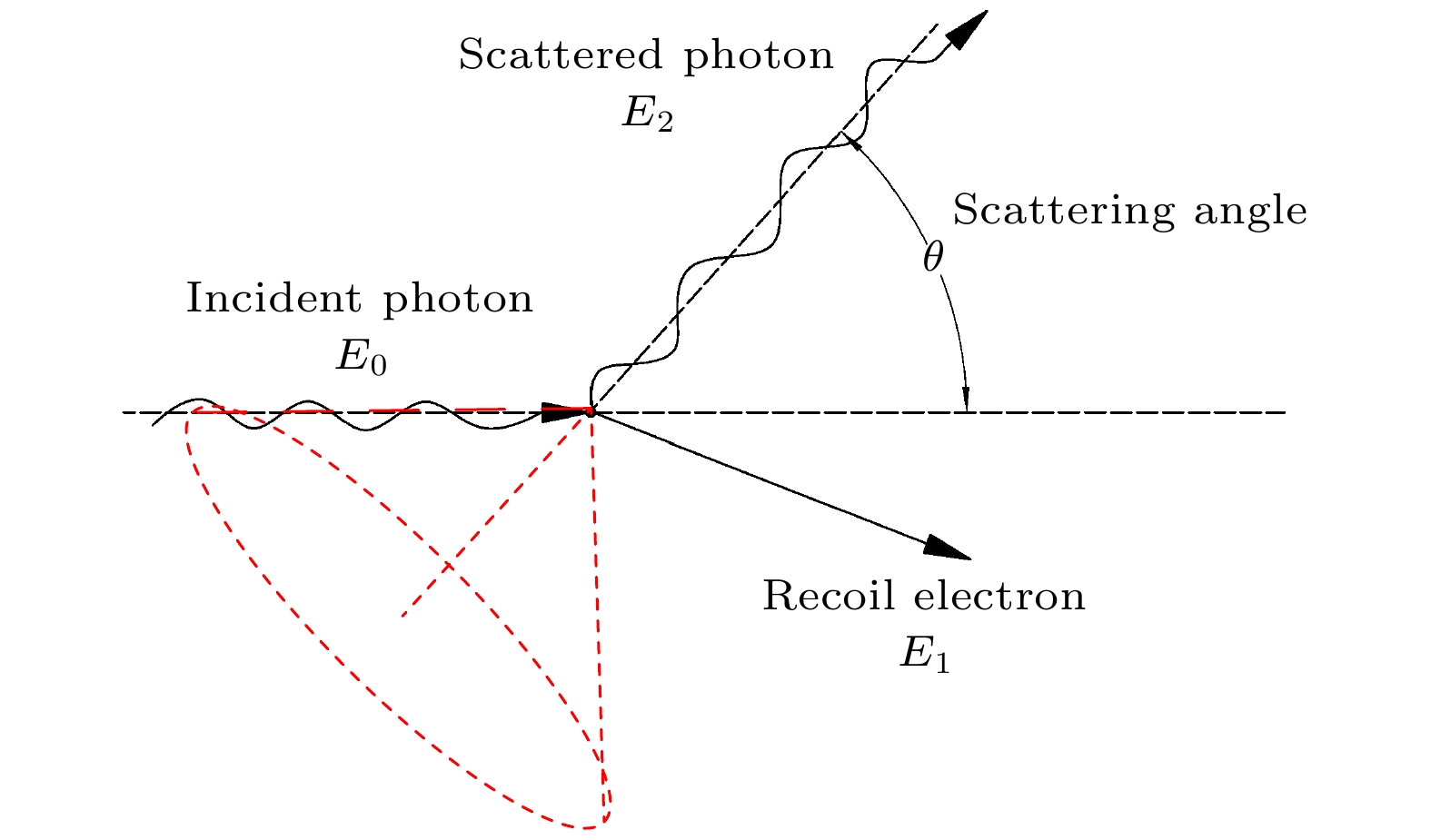
 DownLoad:
DownLoad:
